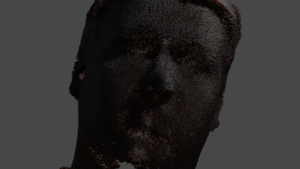USDZ data visualization: Difference between revisions
From wikiluntti
(→Theory) |
|||
| (4 intermediate revisions by the same user not shown) | |||
| Line 3: | Line 3: | ||
Visualize (Pixar, Apple) USDZ data on a computer, using Blender. Blender can import the data but the structure should be converted into a mesh. Thus, a small Python script is used to convert it to a ply mesh. | Visualize (Pixar, Apple) USDZ data on a computer, using Blender. Blender can import the data but the structure should be converted into a mesh. Thus, a small Python script is used to convert it to a ply mesh. | ||
See [[https://github.com/robmcrosby/BlenderUSDZ]] | See [[https://github.com/robmcrosby/BlenderUSDZ]], [https://code.blender.org/2019/07/first-steps-with-universal-scene-description/], https://developer.nvidia.com/usd/tutorials, https://blendersushi.blogspot.com/2018/07/pipeline-understanding-usdz-format-for.html | ||
[[File:PointCloud usdz.png|thumb|The data/image is a point cloud, thus a mesh needs to be generated. ]] | |||
== Theory == | == Theory == | ||
NVidia's prebuilt https://developer.nvidia.com/usd#bin | |||
== References == | == References == | ||
Latest revision as of 20:36, 11 February 2021
Introduction
Visualize (Pixar, Apple) USDZ data on a computer, using Blender. Blender can import the data but the structure should be converted into a mesh. Thus, a small Python script is used to convert it to a ply mesh.
See [[1]], [2], https://developer.nvidia.com/usd/tutorials, https://blendersushi.blogspot.com/2018/07/pipeline-understanding-usdz-format-for.html

Theory
NVidia's prebuilt https://developer.nvidia.com/usd#bin